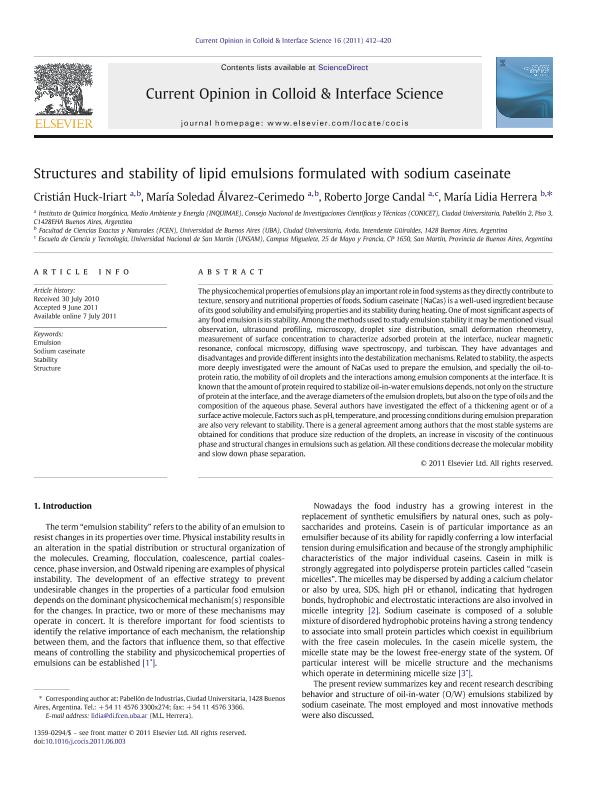Mostrar el registro sencillo del ítem
dc.contributor.author
Huck Iriart, Cristián

dc.contributor.author
Álvarez Cerimedo, María Soledad

dc.contributor.author
Candal, Roberto Jorge

dc.contributor.author
Herrera, Maria Lidia

dc.date.available
2019-03-13T20:38:47Z
dc.date.issued
2011-05
dc.identifier.citation
Huck Iriart, Cristián; Álvarez Cerimedo, María Soledad; Candal, Roberto Jorge; Herrera, Maria Lidia; Structures and stability of lipid emulsions formulated with sodium caseinate; Elsevier Science London; Current Opinion In Colloid & Interface Science; 16; 5; 5-2011; 412-420
dc.identifier.issn
1359-0294
dc.identifier.uri
http://hdl.handle.net/11336/71564
dc.description.abstract
The physicochemical properties of emulsions play an important role in food systems as they directly contribute to texture, sensory and nutritional properties of foods. Sodium caseinate (NaCas) is a well-used ingredient because of its good solubility and emulsifying properties and its stability during heating. One of most significant aspects of any food emulsion is its stability. Among the methods used to study emulsion stability it may be mentioned visual observation, ultrasound profiling, microscopy, droplet size distribution, small deformation rheometry, measurement of surface concentration to characterize adsorbed protein at the interface, nuclear magnetic resonance, confocal microscopy, diffusing wave spectroscopy, and turbiscan. They have advantages and disadvantages and provide different insights into the destabilization mechanisms. Related to stability, the aspects more deeply investigated were the amount of NaCas used to prepare the emulsion, and specially the oil-to-protein ratio, the mobility of oil droplets and the interactions among emulsion components at the interface. It is known that the amount of protein required to stabilize oil-in-water emulsions depends, not only on the structure of protein at the interface, and the average diameters of the emulsion droplets, but also on the type of oils and the composition of the aqueous phase. Several authors have investigated the effect of a thickening agent or of a surface active molecule. Factors such as pH, temperature, and processing conditions during emulsion preparation are also very relevant to stability. There is a general agreement among authors that the most stable systems are obtained for conditions that produce size reduction of the droplets, an increase in viscosity of the continuous phase and structural changes in emulsions such as gelation. All these conditions decrease the molecular mobility and slow down phase separation.
dc.format
application/pdf
dc.language.iso
eng
dc.publisher
Elsevier Science London

dc.rights
info:eu-repo/semantics/openAccess
dc.rights.uri
https://creativecommons.org/licenses/by-nc-nd/2.5/ar/
dc.subject
Emulsion
dc.subject
Sodium Caseinate
dc.subject
Stability
dc.subject
Structure
dc.subject.classification
Alimentos y Bebidas

dc.subject.classification
Otras Ingenierías y Tecnologías

dc.subject.classification
INGENIERÍAS Y TECNOLOGÍAS

dc.title
Structures and stability of lipid emulsions formulated with sodium caseinate
dc.type
info:eu-repo/semantics/article
dc.type
info:ar-repo/semantics/artículo
dc.type
info:eu-repo/semantics/publishedVersion
dc.date.updated
2019-03-08T20:15:39Z
dc.journal.volume
16
dc.journal.number
5
dc.journal.pagination
412-420
dc.journal.pais
Reino Unido

dc.journal.ciudad
Londres
dc.description.fil
Fil: Huck Iriart, Cristián. Consejo Nacional de Investigaciones Científicas y Técnicas. Oficina de Coordinación Administrativa Ciudad Universitaria. Instituto de Química, Física de los Materiales, Medioambiente y Energía. Universidad de Buenos Aires. Facultad de Ciencias Exactas y Naturales. Instituto de Química, Física de los Materiales, Medioambiente y Energía; Argentina. Universidad de Buenos Aires. Facultad de Ciencias Exactas y Naturales; Argentina
dc.description.fil
Fil: Álvarez Cerimedo, María Soledad. Consejo Nacional de Investigaciones Científicas y Técnicas. Oficina de Coordinación Administrativa Ciudad Universitaria. Instituto de Química, Física de los Materiales, Medioambiente y Energía. Universidad de Buenos Aires. Facultad de Ciencias Exactas y Naturales. Instituto de Química, Física de los Materiales, Medioambiente y Energía; Argentina. Universidad de Buenos Aires. Facultad de Ciencias Exactas y Naturales; Argentina
dc.description.fil
Fil: Candal, Roberto Jorge. Consejo Nacional de Investigaciones Científicas y Técnicas. Oficina de Coordinación Administrativa Ciudad Universitaria. Instituto de Química, Física de los Materiales, Medioambiente y Energía. Universidad de Buenos Aires. Facultad de Ciencias Exactas y Naturales. Instituto de Química, Física de los Materiales, Medioambiente y Energía; Argentina. Universidad Nacional de San Martín. Escuela de Ciencia y Tecnología; Argentina
dc.description.fil
Fil: Herrera, Maria Lidia. Consejo Nacional de Investigaciones Científicas y Técnicas; Argentina. Universidad de Buenos Aires. Facultad de Ciencias Exactas y Naturales; Argentina
dc.journal.title
Current Opinion In Colloid & Interface Science

dc.relation.alternativeid
info:eu-repo/semantics/altIdentifier/doi/https://doi.org/10.1016/j.cocis.2011.06.003
dc.relation.alternativeid
info:eu-repo/semantics/altIdentifier/url/https://www.sciencedirect.com/science/article/pii/S1359029411000793
Archivos asociados
